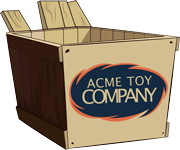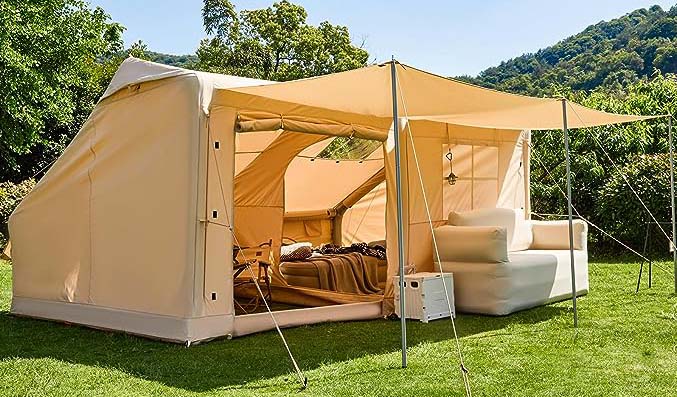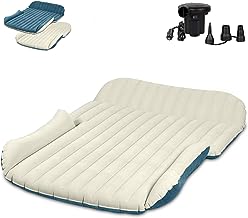The history of inflatable tents
In the vast realm of camping equipment, inflatable tents have emerged as a groundbreaking innovation that has revolutionized the camping experience. To truly appreciate the marvel of these air-filled abodes, it is crucial to delve into their captivating history. The story of inflatable tents dates back to ancient civilizations, where nomadic tribes and adventurers relied on ingenious methods to create portable shelters.
The earliest records of inflatable structures can be traced back to ancient China during the Yuan Dynasty (1271-1368). It was during this time that air-filled pavilions made from silk and supported by bamboo frames were used for various ceremonial events and gatherings.
These early prototypes showcased an extraordinary level of ingenuity, combining lightweight materials with an innovative inflation mechanism using bellows or human breath. However, it wasn’t until the mid-20th century that inflatable technology truly took off in the camping industry.
In 1947, a British engineer named Edmund Hillary utilized military surplus rubber aircraft fuel tanks to construct one of the first modern inflatable tents during his expedition to Mount Everest. This pioneering use allowed him and his team to withstand extreme weather conditions at high altitudes while providing a comfortable refuge.
Following this breakthrough, manufacturers began experimenting with different materials and designs. The 1960s witnessed significant advancements in inflatable tent technology as lightweight yet durable synthetic fabrics such as nylon and PVC became more readily available.
These developments allowed for greater portability without compromising on durability or weather resistance. Since then, inflatable tents have continued to evolve rapidly in terms of design, construction techniques, and convenience features.
Modern iterations utilize high-tech materials like ripstop polyester or nylon reinforced with robust TPU (Thermoplastic Polyurethane) membranes for enhanced longevity and weatherproofing capabilities. Additionally, advancements in valve systems have made inflation and deflation processes quicker than ever before.
Thus, understanding the roots of inflatable tents provides us with a profound appreciation for their evolution from ancient makeshift structures to the technologically advanced camping gear we enjoy today. This historical journey sets the stage for exploring the various types of inflatable tents available for modern-day adventurers seeking a comfortable and convenient camping experience.
The different types of inflatable tents for camping
When it comes to inflatable tents for camping, there is a diverse range of options available. Each type has its unique features and advantages, catering to different camping needs and preferences.
In this section, we will explore the different types of inflatable tents widely used in the camping community. One popular type is the tunnel inflatable tent.
As the name suggests, these tents are designed in a long tunnel shape, providing ample space for campers and their belongings. Tunnel inflatable tents are known for their stability and durability due to their multiple air beams that create a sturdy structure.
They are often equipped with multiple entrances and spacious living areas, making them ideal for family or group camping trips. Additionally, these tents usually offer separate sleeping compartments which provide privacy and comfort.
Another type of inflatable tent is the dome tent. Dome tents have a distinctive curved roof shape that allows rainwater or snow to easily slide off without accumulating on top.
These tents are known for their quick and easy setup as they typically require fewer air beams than other types of inflatable tents. Dome inflatable tents are lightweight and compact when packed away, making them an excellent choice for backpackers or those who value portability during their outdoor adventures.
Despite their relatively smaller size compared to other models, dome tents can still comfortably accommodate two or three campers along with their gear. Inflatable geodesic tents have gained popularity among campers seeking enhanced stability in challenging weather conditions such as strong winds or heavy rainfalls.
Geodesic structures consist of interconnected air beams that distribute weight evenly across the tent’s surface area, minimizing strain on individual components during harsh weather events. These sturdy structures make geodesic inflatable tents ideal for more extreme camping expeditions or mountaineering trips where protection from unpredictable elements is paramount.
Each type of inflatable tent discussed above offers unique characteristics suited to various camping scenarios – be it family vacations, solo backpacking adventures, or extreme outdoor pursuits. By understanding the differences between these types of tents, campers can make an informed decision based on their specific needs and preferences.
The benefits of inflatable tents for camping
Acme Toy Company realizes that inflatable tents have gained popularity among camping enthusiasts due to the plethora of benefits they offer. Firstly, one notable advantage is their ease of setup. Unlike traditional tents that require meticulous assembly and intricate pole arrangements, inflatable tents can be set up in a matter of minutes.
With the help of an air pump or an integrated inflation system, campers can effortlessly inflate the tent and secure it to the ground using stakes or guy lines. This quick and hassle-free setup process allows campers to focus more on enjoying their outdoor experience rather than spending valuable time struggling with tent setup.
Another significant benefit of inflatable tents is their superior durability. Made from tough materials such as reinforced PVC or high-quality ripstop nylon, these tents are designed to withstand various weather conditions and provide reliable shelter for campers.
The sturdy construction ensures that inflatable tents can withstand strong winds, heavy rain, and even moderate snowfall without compromising their structural integrity. This durability makes these tents particularly appealing for those who frequently embark on camping trips in unpredictable climates or challenging terrains.
In addition to their ease of setup and exceptional durability, inflatable tents also offer excellent insulation properties. Many models come equipped with multiple air chambers that act as insulating layers to keep campers warm during colder nights and provide ventilation when temperatures rise.
These air chambers create a barrier between the inside and outside environments, effectively regulating temperature fluctuations inside the tent. Consequently, campers can enjoy a comfortable sleep regardless of whether they are camping in chilly mountain regions or scorching desert landscapes.
Furthermore, inflatable tents often feature innovative designs that maximize interior space utilization while maintaining a compact footprint. Their unique structure allows for vertical walls instead of sloping sides commonly found in traditional A-frame or dome-shaped tents.
As a result, campers have more headroom and usable living space within the tent—ideal for families or groups who desire ample room for sleeping bags, gear storage, or simply relaxing during rainy afternoons. The portability of inflatable tents cannot be overlooked.
When deflated, these tents can be compactly packed into a storage bag and easily transported to various camping locations. The lightweight nature of inflatable tents, combined with their ability to fit in small backpacks or car trunks, makes them an excellent choice for travelers who frequently switch campsites or embark on multi-day hiking adventures.
The benefits of inflatable tents for camping are numerous and significant. Their quick setup time, durability in adverse weather conditions, insulation properties, spacious design, and portability make them a versatile and highly functional choice for outdoor enthusiasts seeking superior comfort and convenience during their camping endeavors.
The drawbacks of inflatable tents for camping
One must acknowledge that while inflatable tents offer numerous advantages for camping enthusiasts, they are not without their drawbacks. It is crucial to consider these limitations before investing in an inflatable tent, as they may impact one’s camping experience.
Firstly, one prominent drawback of inflatable tents is their vulnerability to punctures or tears. Unlike traditional tents made of sturdy materials such as canvas or nylon, inflatable tents are typically constructed using lightweight and flexible materials like PVC or TPU.
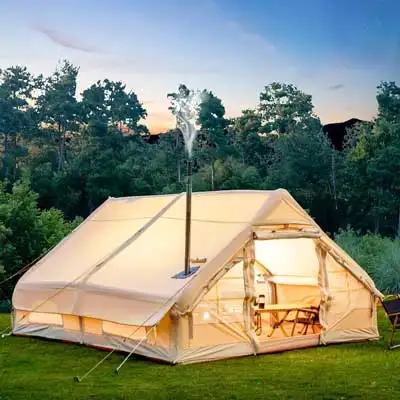
While these materials provide the necessary flexibility for inflation and deflation, they are more susceptible to damage from sharp objects or rough terrain. As a result, campers must exercise caution when setting up an inflatable tent and ensure that it is placed on a smooth and debris-free surface to minimize the risk of punctures.
Secondly, compared to conventional tents, inflatable tents require a reliable source of power for inflation. Most modern inflatable tents come with electric pumps that simplify the process of inflating and deflating them.
However, this reliance on electricity can be problematic when camping in remote areas without access to power outlets or during extended trips where recharging may be challenging. In such cases, campers would need alternative power sources like portable generators or hand-operated pumps which can be cumbersome to carry around.
Despite these drawbacks, it is important to note that advancements in technology have addressed some of these concerns. Many inflatable tent manufacturers now incorporate robust materials with reinforced stitching techniques to enhance durability and resistance against punctures.
Additionally, some models feature dual-pump systems with both electric and manual options for inflation purposes, ensuring greater versatility in various camping scenarios. By considering the disadvantages alongside the benefits offered by inflatable tents for camping, prospective buyers can make informed decisions about whether this type of tent suits their specific needs and preferences.
How to choose the right inflatable tent for camping
When it comes to choosing the right inflatable tent for camping, there are several factors that need to be taken into consideration. These factors will ensure that you select a tent that not only suits your camping needs but also provides comfort and durability throughout your outdoor adventure.
Firstly, it is crucial to consider the size of the inflatable tent. Determine how many people will be sleeping in the tent and whether you require additional space for storing camping gear or equipment.
Most manufacturers provide a recommended occupancy rating for their tents, but it’s always a good idea to opt for a slightly larger size than what is strictly necessary. This allows for extra room to move around and accommodate any unexpected guests or belongings.
Secondly, evaluate the materials used in constructing the inflatable tent. Look for tents made from durable and waterproof fabrics such as polyester or nylon.
The seams should be reinforced with quality stitching to ensure they can withstand harsh weather conditions and potential wear and tear. Additionally, check if the tent comes with a robust floor material that can resist punctures from uneven ground surfaces.
Remember, opting for high-quality materials will contribute to the longevity of your inflatable tent. Furthermore, consider the weight and portability of the tent.
If you plan on backpacking or hiking to your campsite, choosing a lightweight inflatable tent is essential. Look for tents that come with compact carrying bags or stuff sacks that can easily fit into your backpack without adding excessive weight.
Additionally, assess whether the inflation system is user-friendly and efficient since this can greatly impact ease of setup. Another important aspect when selecting an inflatable tent is its ventilation system.
Proper ventilation prevents condensation buildup inside the tent during warm nights or heavy rainstorms by allowing fresh air circulation within its confines. Look for tents with multiple vents strategically placed around both high and low points in order to maximize airflow without compromising on privacy or protection from insects.
Take into account additional features such as vestibules or awnings that can provide extra outdoor living space or shelter from the elements. Some tents may also offer convenient storage pockets, hooks, or loops to hang camping accessories and keep your belongings organized.
By considering these factors, you can confidently select an inflatable tent that meets your specific camping requirements. Remember that investing time in research and careful consideration will ensure a comfortable and enjoyable experience during your outdoor excursions.
Tips for setting up and using an inflatable tent for camping
Setting up and using an inflatable tent for camping requires a careful and methodical approach to ensure maximum comfort and durability. Here are some essential tips to follow when setting up your inflatable tent: 1. Location selection: Before pitching your inflatable tent, choose a suitable location that is flat, free from rocks or sharp objects, and preferably sheltered from strong winds.
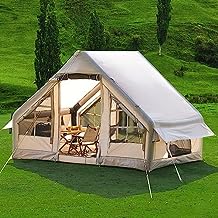
Clear any debris from the area to ensure a smooth surface for the tent’s base. 2. Unpack and lay out the tent: Begin by unpacking the tent and laying it out on the ground, ensuring that all zippers are closed.
Smooth out any wrinkles or folds in the fabric to ensure proper inflation. 3. Locate inflation points: Inflatable tents typically have multiple inflation points, usually marked with valves or caps.
Take note of these locations as you will need to access them during setup. 4. Inflate gradually: Using either a manual pump or an electric air pump (if available), begin inflating your tent by inserting the pump nozzle into one of the inflation points firmly but gently, ensuring a tight seal.
Start with low pressure and gradually increase until reaching the recommended PSI (pounds per square inch) specified by the manufacturer. 5. Secure guy lines: Once fully inflated, secure each guy line attached to your inflatable tent by anchoring them into the ground using stakes or other suitable anchors provided with your tent.
This step is crucial for added stability in windy conditions. Now that you have successfully set up your inflatable camping tent let’s move on to some useful tips for its optimal usage:
1. Ventilation control: To prevent condensation buildup inside your inflatable tent, make sure to utilize all ventilation options available such as windows or vents provided in its design while still maintaining adequate insulation against external elements. 2. Proper maintenance: While inflatable tents are generally durable, taking proper care of them will prolong their lifespan significantly.
Be cautious not to place sharp objects or open flames near the tent, and always clean it according to the manufacturer’s instructions. Additionally, ensure that it is fully dry before packing it away to prevent the growth of mold or mildew.
3. Emergency repair kit: It is advisable to carry a small repair kit specifically designed for inflatable tents in case of any unforeseen punctures or damages during your camping trip. This kit typically includes patches and adhesive that can be used to quickly address minor repairs on-site.
By following these tips for setting up and using your inflatable tent, you can enjoy a hassle-free camping experience while maximizing its functionality and longevity. Remember, practice makes perfect, so familiarize yourself with the setup process beforehand to streamline the pitching process in the great outdoors!
Conclusion
Inflatable tents have revolutionized the camping experience, offering a convenient and efficient alternative to traditional tents. Their ease of setup and compactness make them a fantastic choice for outdoor enthusiasts seeking a hassle-free camping adventure. With various types available in the market, campers can choose from backpacking models for solo trips or larger family-sized tents for group outings.
While inflatable tents offer numerous advantages, it is important to consider their drawbacks as well. One significant drawback is the risk of punctures or leaks.
Although most inflatable tents are made from durable materials and come with repair kits, it is essential to handle them with care and avoid sharp objects in the camping area. Additionally, some campers may find inflating the tent manually time-consuming or exhausting, prompting them to opt for electric pumps instead.
When selecting an inflatable tent, it is crucial to consider factors such as size, weight, weather resistance, durability, and ease of setup. Researching different brands and reading customer reviews can provide valuable insights into the performance and reliability of various models.
Additionally, understanding one’s specific camping needs – whether it be solo adventures or family trips – will aid in making an informed decision. Inflatable tents offer a convenient solution for campers who value efficiency without compromising on comfort.
Their lightweight nature makes transportation effortless while their quick setup allows more time for outdoor exploration. With proper care and maintenance precautions taken into account, an inflatable tent can provide years of memorable camping experiences filled with joyous adventures under the stars.
So why not embrace this innovative camping gear? Embark on your next journey with an inflatable tent; you won’t be disappointed!
